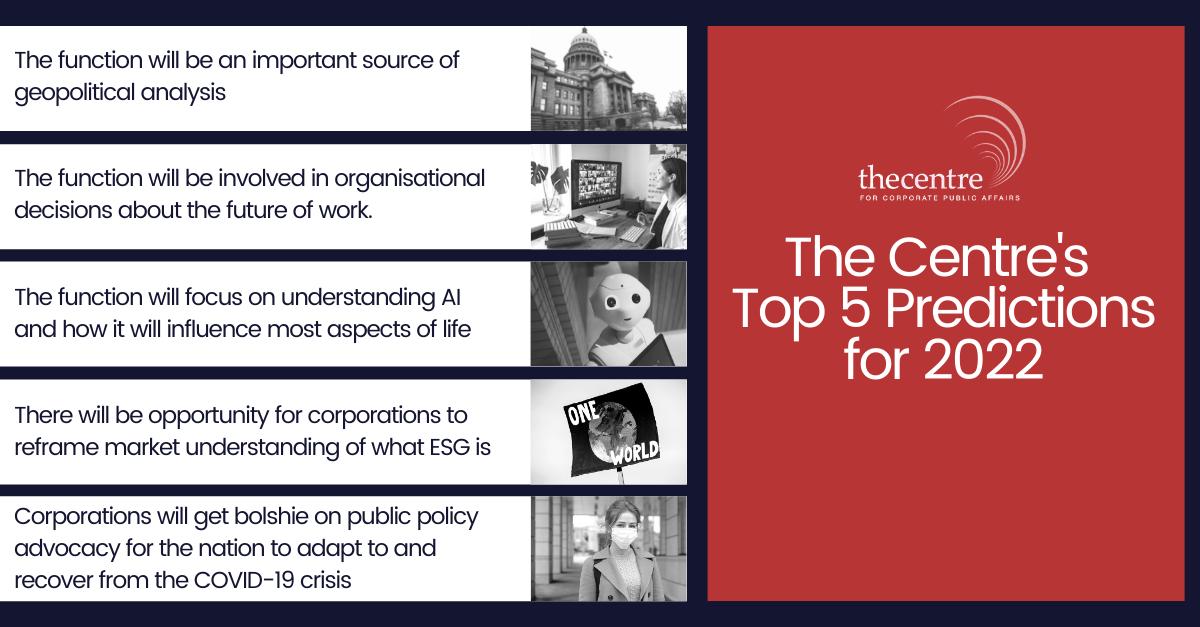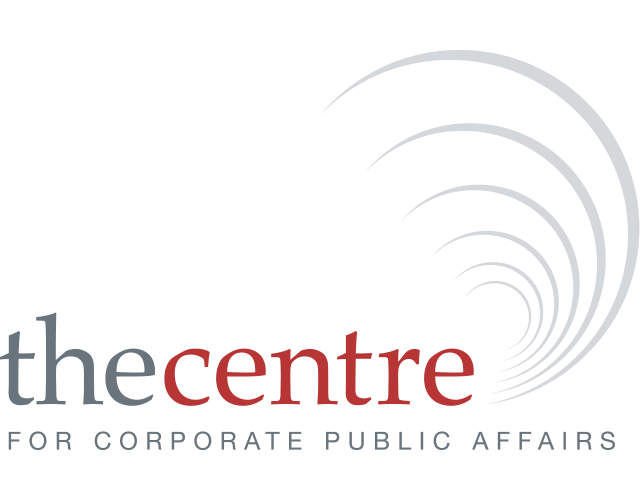
Centre for Corporate Public Affairs Top Five Predictions for 2022
US baseball playing philosopher Yogi Berra said: “… never make predictions – especially about the future.”
We’ve been taking on Berra’s curve-ball for some years now to forecast trends and developments in the practice of corporate public affairs across Asia Pacific.
Amid global pestilence and the uncertainty it breeds, we’re sticking our neck out again in 2022 by offering our Top Five Predictions in corporate public affairs.
Our Top Five Predictions last year gelled for many practitioners as 2021 stopped and started as humanity sought to adapt to COVID-19. Our 2021 predictions, made at this same time last year were:
1. Managing issues remotely/virtually is here to stay.
2. Mediocrity is not good enough.
3. Re-imagining stakeholder engagement.
4. Crisis planning to the fore.
5. More public policy and employee activism.
But wait, there’s more to come in 2022.
Based on our discussions with heads of corporate public affairs across Asia Pacific, our management consulting work across the world with corporations, industry groups, and governments, 2022 will again be an issues-rich 12 months for the function and its practitioners.
1. The function will be an important source of geopolitical analysis
Geopolitics in Asia Pacific especially (with China and India at the socio-political centre) and the ugly side of the nationalist face in Eastern Europe, including Russia, has the potential to affect business, civil society, and macro-economic settings globally. Think supply chains, inflation, business and consumer confidence, interest rates, market access, economic sanctions.
US President Joseph Biden said last year we are living at a juncture where “… We have to prove democracy still works.” Commerce and its flow of capital, people, and ideas may increasingly be enlisted by governments to push back against autocracy.
How China interacts with the world and how nations, economies, industries, and corporations interact with China can affect domestic economic settings across Asia Pacific nations, including everything from electricity prices, the cost of capital, interest rates, industry viability (think iron ore, wine, education exports, tourism), supply of goods, and influence also the local political weather.
Aggression towards Taiwan. Artificial trade barriers to the EU, the US, Norway, Australia, Brazil. Increasing China foreign aid in the South Pacific, Indochina, and Africa. An all-out effort for the Chinese Communist Party to harness nationalism to evolve more rapidly towards a domestic consumption economy. Wolf diplomacy.
China looms large.
In 2021, more so than at any time in the last decade, boards and senior executive teams have asked the corporate public affairs team to contribute geopolitical interpolation to organisational strategy and decisions.
Whether domestically focused or an exporter, if capability and capacity to analyse and understand how geopolitical developments do and could affect industries, corporations and their socio-political environments do not reside in-house, we forecast many a head of function will need to dust off their contact book to source China/Asia and US-European-Australian relations experts to add to their roster of trusted external advisors.
2. The future of work
Many a practitioner will suffer immediate fatigue even reading those words.
How we adapt to work during a deadly pandemic, on the frontline or away from the office that was our haunt for five-days a week, has been an evolving issue inside organisations, a public policy conundrum, and a challenge for leaders of the corporate public affairs function with its many fast-moving parts.
The function has been a member of the internal brains trust since March 2020 when the pandemic was declared, engaging with external stakeholders to understand public health orders and their impact, chip in public policy ideas and insights, and plot and implement internal communication and employee engagement strategy, which included employee well-being in workplaces that overnight increased from hundreds of thousands to millions, as kitchen tables morphed into work stations.
Since then there have been mountains of words written about the future of work for employees able to work from home, including some based on research into productivity of employees working from home, the ‘Great Resignation’ as employees decided a meaningful life did not mean climbing the corporate greasy career pole (to-date a US and UK phenomenon, and the consequences of ‘no jab, no work’ corporate vaccination mandates).
How organisations adapt to employee, employer, government, and social expectations about how and where we work during the next few years will see corporate public affairs disciplines at the heart of deliberations (internal communications, government relations and policy, stakeholder engagement, corporate responsibility, media relations, community relations); and areas of practice applied to managing adaption (policy development, issues management, stakeholder engagement and communications).
As flagged in our Top Five Predictions in 2021 managing issues by practitioners plying their trade in multiple work spaces became de rigueur in 2021 (this has been the natural state of things for decades in multinational entities). Managing issues without all those managing them required to be physically in a head or divisional office – a considerable concern and fear for many practitioners during 2020 – has, in the lived experience, worked out fine.
Unchanged since the pandemic started is that timely information remains the currency of the practice of corporate public affairs. And one advantage of exchanging that currency is the core of the function’s practitioners were physically located in a designated area of the office, or within a few floors of each other.
If that is not going to be so in 2022 and beyond, a significant challenge for heads of function and disciplines is to manage processes to make sure that timely information is flagged and shared to team members wherever they are physically working.
3. Understanding and living with AI
Regardless of industry, sector, or business, how Artificial Intelligence is developing and being applied to developing and manufacturing goods and services, marketplaces, security (including defence), logistics, back-office processing, customer service, and other business processes, is at a tipping point. Legislators, regulators, boards of governance, and senior executives are lagging in their understanding of the real-world application of AI today, and where it’s heading – fast.
AI is embedded in a multitude of standard business processes, its application opaque to most of an organisation’s internal and external stakeholders.
Because it is not well understood in the community it can be easy to demonise AI embedded in a product or service supply chain.
As well, decisions to apply AI in organisational operations can occur without any social-political assessment, the remit of corporate public affairs.
In 2022 expect to see heads of function more active around engaging their teams and internal and external stakeholders about the role of AI in the organisation and the industry and sector in which it operates. News media and the social media commentariat is more interested in AI also, and ready to say ‘gotcha’ when AI outputs and outcomes generate negative stakeholder experiences, or material issues for the corporate reputation.
4. Reality check on ESG – a narrow window to influence market analysts’/news media view of what good ESG performance looks like
In 1983 the US and Australia were dazzled by the Cabbage Patch Doll craze (most practitioners under 50 years old are now typing into their search engines). 2021 was a bit like that as market analysts and business journalists were either enamoured by or railed against ESG – a company’s commitment to and performance against environmental, social, and governance goals.
Old hat to corporate public affairs teams managing corporate responsibility strategy, engagement, and reporting since the late 1990s, ESG came to the fore as big superannuation and investment funds stated an entity’s ESG performance was important for them. ESG was having its Cabbage Patch Doll moment with many corporate stakeholders previously only mildly interested in it and its contribution to social license to operate.
Expect to see corporate public affairs leaders harness new and intense market/financial interest in ESG to engage stakeholders and news media to frame the ESG performance of their organisation, including, for those that can, with more than two decades of ESG commitments, performance against targets, and reporting.
5. Corporations get bolshie on their COVID-19 adaption public policy advocacy
The developed world is at the adaption phase of the pandemic crisis (phase one = chaos; phase 2 = acceptance; phase three = adaption; phase four = recovery). And the adaption phase of any crisis offers the most significant opportunities to, well, adapt.
Nations with less representative systems of government have imposed, often by fiat, how economies, health and education systems, and urban environments adapt, including in Asia Pacific.
In nations with more representative governments, civil society and business have more opportunity to identify opportunities to adapt and in doing so strengthen social and economic outcomes.
Most leaders of corporations agree that even before the pandemic, governments in Australia seemed allergic to big, essential policy change, including in regulation, aged care, education, the tax system, infrastructure development, health care, gender justice for women, the Voice for First Nation Australians, immigration, and industrial relations.
The urgency to adapt and eventually recover from the pandemic will, we forecast, see many more CEOs and their boards advocate publicly and assertively for change and reform to better prepare the nation for future pandemics, expanding their advocacy beyond the arena of being closed door advocacy with Ministers, other MPs, and public servants, to include the public arena.
The objective will be to build broader community momentum to get the things done corporations and industries believe are necessary to sustain an equitable and prosperous recovery.
And the corporate leaders more vocal about the rationale for change will ramp up their advocacy with or without alignment with the public policy positions of industry or business groups of which their companies are members.
The Way We Were - Centre predictions in past years
The year that was: Centre Top Predictions for 2021
1. Managing issues remotely/virtually is here to stay.
2. Mediocrity is not good enough.
3. Re-imagining stakeholder engagement.
4. Crisis planning to the fore.
5. More public policy and employee activism.
The year that was: Centre Top Predictions for 2020
1. A shift from ‘cooperation’ between the corporate public affairs and marketing management functions to far more ‘collaboration’.
2. More Boards will approach and monitor corporate reputation as a material risk.
3. More community expectations of high-performance corporate responsibility.
4. The emergence of the campaign manager role.
5. More 2ICs to the corporate public affairs Head of Function.
The year that was: Centre Top Predictions for 2019
1. More companies will get involved with and engage with social issues.
2. The Investor Relations discipline will begin migrating back to the corporate public affairs management function.
3. Heads of Function will seek more diversity of thought in their teams.
4. Arms Race for advocates.
5. Campaigns and coalitions are back.
The year that was: Centre Top Predictions for 2018
1. More psychographic profiling using Big Data.
2. Boards want more frequent reputation research.
3. More demand for generalist practitioners.
4. Many public affairs teams will get bigger.
5. Corporate brand management will be back in the function.
The year that was: Centre Top Predictions for 2017
1. The evidence-base Arms Race.
2. The beginning of the end of the corporate Intranet.
3. The digital production-savvy corporate public affairs practitioner.
4. Infographic mania.
5. More women leading the management function.
The year that was: Centre Top Predictions for 2016
1. Stakeholders at the heart of corporate public affairs strategy.
2. Social Media Command Centres.
3. Public affairs night shifts will be introduced in some organisations to monitor issues, and provide rapid socio-political response.
4. Renaissance of the corporate narrative.
5. Public Affairs helping their organisation understand the Asian Century.
The year that was: Centre Top Predictions for 2015
1. Convergence of internal and external communications.
2. More cooperation between public affairs and marketing departments.
3. Application of heuristics to corporate stakeholder communications.
4. Stakeholder research becoming an essential input to public affairs strategy and planning.
5. Advent of a 'common market' for corporate public affairs skills across Australia and Asia.
